Ding Yu-Fan: "Application of Modern Material Analysis and Testing Technology and Surface Treatment Technology in the Archaeology and Conservation of Stone Cultural Relics" & Lecture Communication
On October 27, 2023, the second session of the "Archaeological Science Forum" hosted by the Center for Archaeological Science, Sichuan University was held in the conference room on the first floor of the China Tibetology Research Institute, Wangjiang Campus, Sichuan University. Dr. Ding YuFan gave a lecture entitled "Application of Modern Material Analysis and Testing Technology and Surface Treatment Technology in the Archaeology and Conservation of Stone Cultural Relics", which was chaired by Professor Li YingFu from the School of History and Culture of Sichuan University.
Dr. Ding YuFan shared some of her recent research results, mainly on the research and protection of stone cultural relics in the Batalha Monastery. By showcasing various material analysis technologies and surface treatment technologies, she provided a comprehensive introduction to the source tracing, degradation mechanism, cleaning, and protection research of the limestone building materials in the Batalha Monastery.
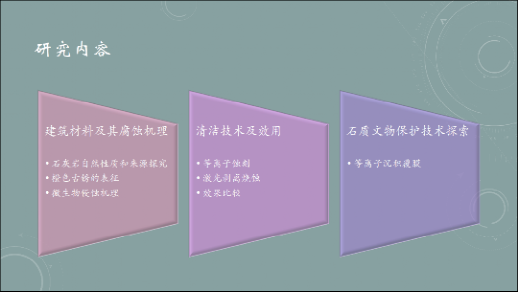
Research Content of Dr. Ding YuFan
The Batalha Monastery is one of the most famous iconic monuments in Portugal and a UNESCO World Heritage Site. It currently faces serious building surface deterioration, with problems such as orange-brown ancient rust and microbial corrosion requiring urgent solutions. The research team used petrographic thin-section observation, X-ray diffraction analysis (XRD), thermogravimetric analysis (TGA), and X-ray fluorescence analysis (XRF) to trace the origin and study the chemical mineralogical characteristics of the limestone materials used in the monastery's construction. They successfully located the production areas of most of the materials used during the construction and reconstruction of the Batalha Monastery, deeply analyzed the physical and chemical properties of these rock materials, explored the damage mechanisms of such building weathering, and demonstrated the advantages of new technology material analysis techniques.
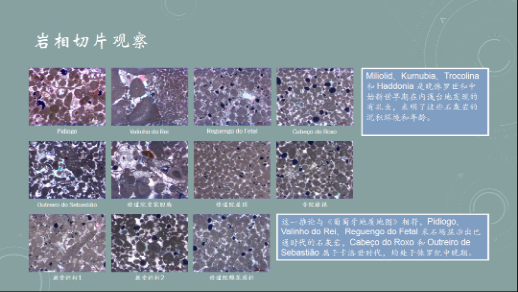
Petrographic Thin-Section Observation
Through the study of the orange ancient rust degradation characteristics on the outer walls and building reliefs of the monastery using micro-area X-ray diffraction analysis (XRD) and variable-pressure scanning electron microscopy, it is known that the formation of ancient rust has different causes in different regions and is closely related to the building materials used. The complete process of limestone material being eroded by microorganisms was analyzed through DNA sequencing of disease samples from the outer walls and scanning electron microscopy with energy-dispersive X-ray spectroscopy. DNA sequencing technology for the identification of lichen and bacteria populations on the wall surface shows that nitrogen, phosphorus, sulfides, organic molecules, and other elements rich in urban environmental pollution promote the growth of organisms on the wall surface, which can accelerate the degradation of stone buildings by biological mechanisms.
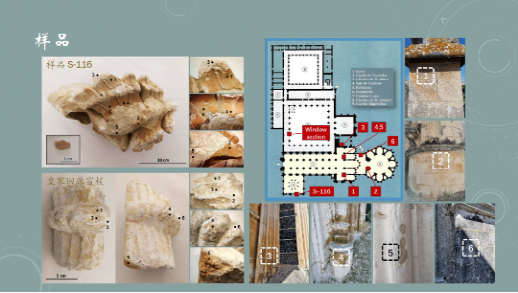
Samples
Plasma etching technology can be used to clean limestone blocks in the early stage of microbial colonization, and the ability of plasma etching to inhibit microbial erosion is evaluated using Fourier transform infrared spectroscopy (FTIR), variable-pressure scanning electron microscopy, and cell viability index (CVI).
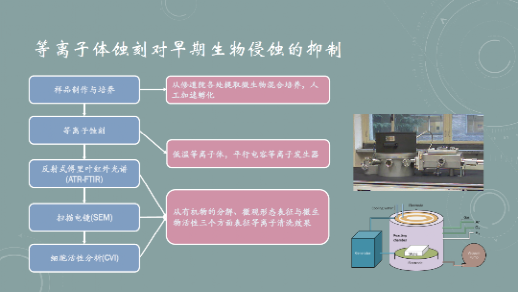
Inhibition of Early Biological Erosion by Plasma Etching
This study also used laser ablation technology with four different irradiation modes to treat the lichen crust on the limestone of the monastery. At the same time, various methods such as X-ray diffraction analysis (XRD), inlaid thin sections, and scanning electron microscopy were used to compare the effects and detect safety in order to obtain the most suitable treatment plan.
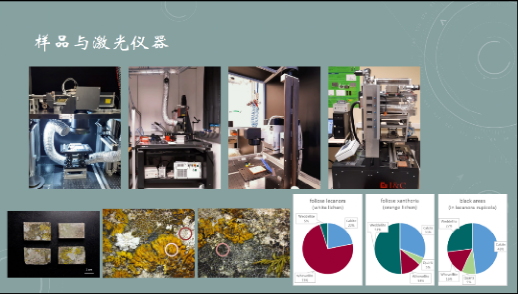
Samples and Laser Instruments
Finally, Dr. Ding YuFan introduced a method of protecting outdoor limestone relics using plasma-deposited film technology. After tests such as acid solution erosion, microbial culture, and outdoor exposure, and after characterization using Fourier transform infrared spectroscopy (FTIR) and inlaid thin-section scanning electron microscopy with energy-dispersive X-ray spectroscopy, it was confirmed that the film has a significant effect in protecting stone from environmental erosion by pollutants and microorganisms. Studies have shown that the film can form a corrosion-resistant coating on the surface of the stone, protecting it from acid rain and slowing down the microbial colonization process.
In summary, this lecture introduced the application of methods such as scanning electron microscopy (SEM), X-ray diffraction analysis (XRD), X-ray fluorescence analysis (XRF), Fourier transform infrared spectroscopy (FTIR), and thermogravimetric analysis (TGA) in the source tracing, degradation mechanism, cleaning, and protection research of stone materials from multiple aspects.
Professor Feng GuoYing, Dean of the School of Electronic Information of Sichuan University, made a comprehensive review. She pointed out that using various material analysis technologies for stone cultural relic protection research is a very cutting-edge topic and has important application value and practical significance. She looks forward to comprehensive, in-depth, and systematic cooperation with the Center for Archaeological Science in the future, so that the laser technology that has been mastered can play a greater role in the process of cultural relic protection, and jointly promote the development of China's cultural relic protection cause. In addition, the participating teachers and students focused on the application of multi-disciplinary technologies in cultural relic protection and other issues for in-depth discussions, exploring more means to promote the transformation of advanced technologies from laboratory research to practical cultural relic protection application scenarios.
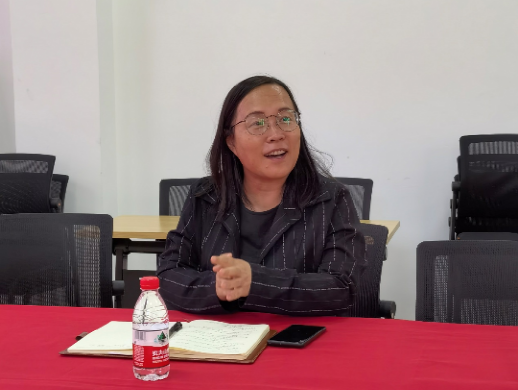
Comments by Professor Feng GuoYing
Ding YuFan received the EU Marie Curie Scholarship in 2018 to engage in archaeological material research in Europe. In 2023, she received a double Ph.D. in Materials Science from the Polytechnic University of Turin and Geology from the University of 脡vora. She is currently a full-time postdoctoral fellow at the Center for Archaeological Science, Sichuan University, and mainly engages in research on the degradation mechanism of cultural relics and cultural relic protection. Through material analysis methods and material surface modification technology, she carries out research on scientific and technological archaeology of stone cultural relics and new cleaning and protection methods for stone cultural relics. As the first author, she has published four research papers in the field of archaeological conservation in journals such as Environmental Science and Pollution Research and Corrosion and Material Degradation, and two conference papers. She is currently planning to carry out protection research on grotto temples in the Bashu area.
